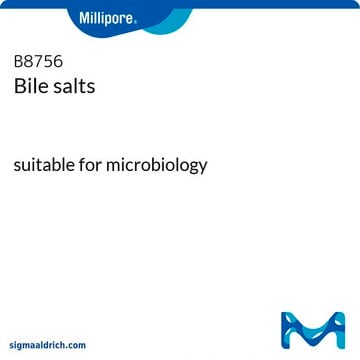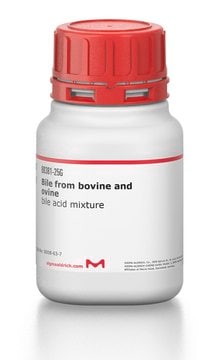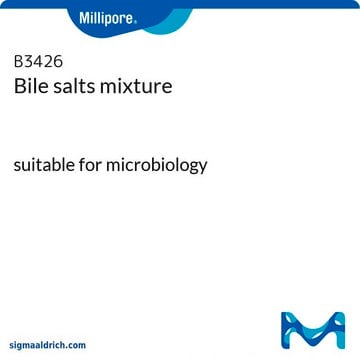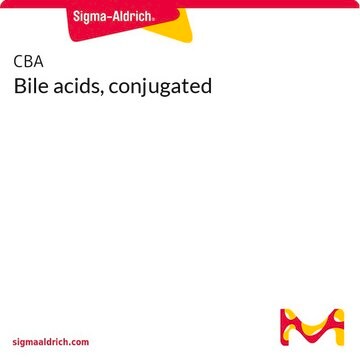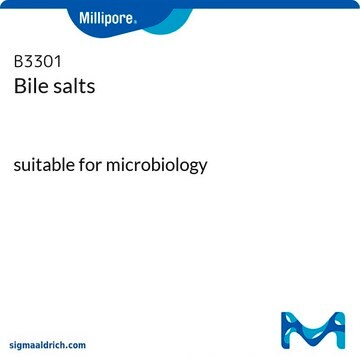48305
Bile salts
suitable for microbiology
Synonim(y):
Bile acids sodium salt, cholic acid-deoxycholic acid sodium salt mixture, Bile acids sodium salt, Cholic acid-Deoxycholic acid sodium salt mixture
Wybierz wielkość
551,00 zł
Wybierz wielkość
About This Item
551,00 zł
Polecane produkty
opis
anionic
Poziom jakości
sterylność
non-sterile
Próba
40-60% (Cholic Acid ; approximately 50% sodium cholate and approximately 50% sodium deoxycholate, HPLC)
Formularz
powder
skład
cholic acid sodium salt, ~50%
deoxycholic acid sodium salt, ~50%
zanieczyszczenia
≤5% water
strata
≤5% loss on drying (water)
rozpuszczalność
H2O: 0.1 g/mL, clear, faintly yellow
Zastosowanie
microbiology
temp. przechowywania
10-30°C
Opis ogólny
Bile salt is an organic sodium salt with a conjugate of any of the bile acids along with either glycine or taurine. Biles salts are composed of four different kinds of bile acids - cholic, deoxycholic, chenodeoxycholic and lithocholic acids.
Bile salts are extracted under controlled conditions from purified fresh bile, to be used in bacteriological culture media, where it behaves as a selective inhibitory agent that enables isolation and identification of pathogens. For example, in MacConkey Agar/Broth.
Zastosowanie
Działania biochem./fizjol.
Kod klasy składowania
11 - Combustible Solids
Klasa zagrożenia wodnego (WGK)
WGK 3
Temperatura zapłonu (°F)
Not applicable
Temperatura zapłonu (°C)
Not applicable
Środki ochrony indywidualnej
Eyeshields, Gloves, type N95 (US)
Wybierz jedną z najnowszych wersji:
Masz już ten produkt?
Dokumenty związane z niedawno zakupionymi produktami zostały zamieszczone w Bibliotece dokumentów.
Klienci oglądali również te produkty
Produkty
Culture media provides a habitat with suitable nutrients, energy sources, and certain environmental conditions for the growth of microorganisms. The components of the culture media range from simple sugars to peptones, salts, antibiotics, and complex indicators.
Podłoże hodowlane zapewnia środowisko z odpowiednimi składnikami odżywczymi, źródłami energii i określonymi warunkami środowiskowymi dla wzrostu mikroorganizmów. Składniki podłoża hodowlanego obejmują zarówno cukry proste, jak i peptony, sole, antybiotyki i złożone wskaźniki.
Active Filters
Nasz zespół naukowców ma doświadczenie we wszystkich obszarach badań, w tym w naukach przyrodniczych, materiałoznawstwie, syntezie chemicznej, chromatografii, analityce i wielu innych dziedzinach.
Skontaktuj się z zespołem ds. pomocy technicznej